"Polymers are valuable if used appropriately"
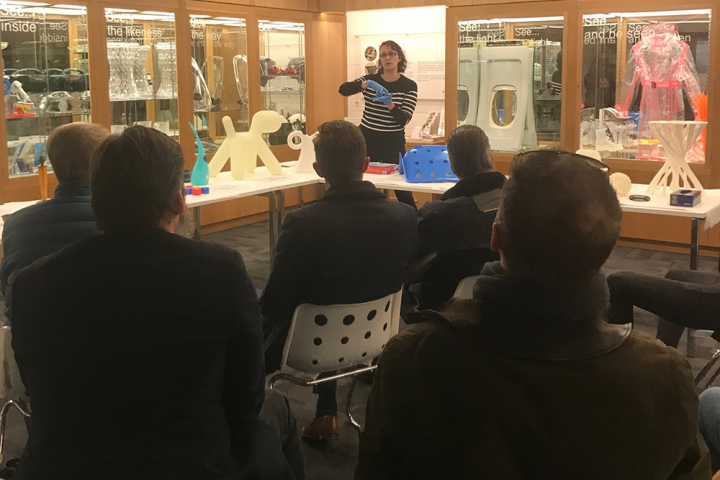
First of all, could you introduce us to MoDiP?
The Museum of Design in Plastics (MoDiP) grew out of a collection of different objects accumulated by the teaching staff of Arts University Bournemouth (AUB) who felt that learning about design and its history would be much more interesting if it was illustrated with real objects rather than just books or pictures.

The MoDiP storeroom where over 11,500 are housed |
Over time, the University, convinced of the value of this collection of objects, which had grown considerably, decided to exploit it.
It became clear that a large part of the collection was made up entirely or partly of plastic objects.
|
The decision was therefore taken in 2007 to reorient the museum towards plastic objects and our approach has not changed since then. Our knowledge of polymers has improved and the collection is now internationally recognised as an important resource for design and plastics research.
Who are the main visitors of the museum?
The museum is located in the university library and we host researchers and academics from different backgrounds. We also like to make links with professionals from other museums, the design and plastics industries, the general public... in the UK, of course, but also outside our borders. We have a lot of online visitors who use our website (www.modip.ac.uk) and social media to find out about the collection and access the various resources we provide online.
In the museum, do you educate by showing that there are many different polymers?
The aim of the museum is to show how rich this family of materials is in its diversity. Each polymer has its own specific properties, so none of them are universal. This is also the case for the other families of materials.
Polymers are valuable if used appropriately. We fully recognise the negative impact that the misuse of plastics can have on the environment and health, but we believe that by learning from the past, manufacturers, designers and consumers can make more informed choices. It is also essential to educate by explaining what can and cannot be recycled.
That said, with more thought and time, almost all plastics could be recycled. If this is not yet the case, it is because more effort needs to be put into research but also because the costs of recycling are still too high.
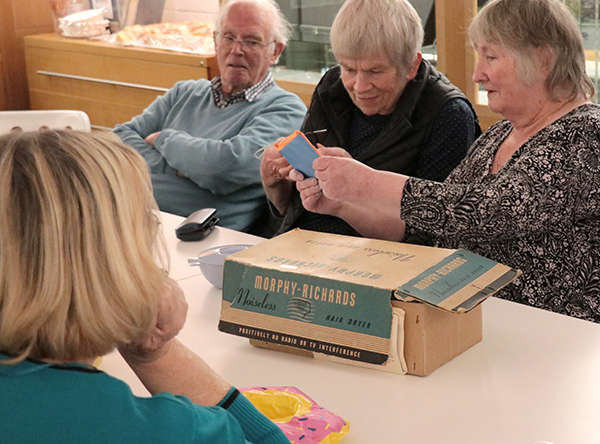
Visitors of all ages enjoy engaging with the collection |
What do you think are the most outstanding pieces?
The collection comprises about 11,500 objects! We think they are all remarkable. So it's really difficult to choose. Among them is a cellulose nitrate billiard ball from the 1860s, which is very representative of the beginning of the history of plastics.
|
At the time, billiards had become such a popular game that the elephant ivory used to make the balls was increasingly difficult to find because of a Civil War embargo. |

A Parkesine billiard ball dating from the 1860s |
I could also mention Tom Dixon's Fresh Fat chair created in 2006. It is made from an extruded copolyester which gives it a glass-like shine. What is interesting is that this chair is handmade. We often tend to think that plastic objects are always mass-produced, whereas each piece is made to order and therefore has a unique appearance, the loops that make up its pattern and structure depend on the hand movements of the maker. A recent acquisition also comes to mind, the Myelin bicycle helmet, which we first came across in an article in your magazine. It is designed to be easily dismantled for easy recycling. This helmet is remarkable, showing the role that eco-design plays in the circularity of plastic objects.
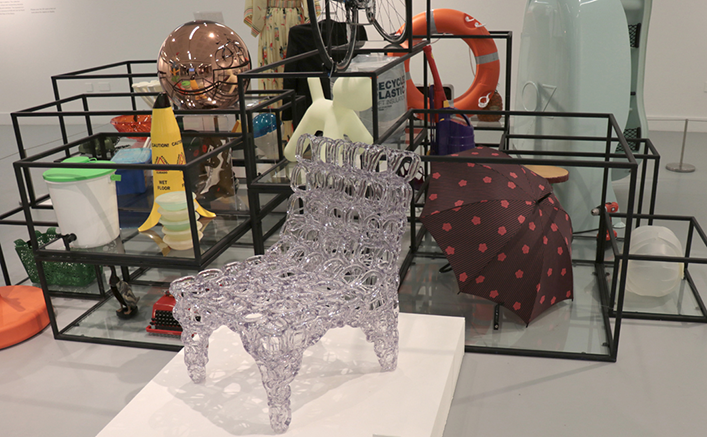
Objects in the museum’s ‘Designated Design: a plastics collection of national importance’ exhibition on display in the AUB’s Gallery including the Tom Dixon Fresh Fat chair |
The use of plastics has changed over the last few decades. Can you tell us about this and what it is like today?
I wrote a whole chapter in my PhD thesis about the perception of plastics and how that perception has changed over the years. It's a fascinating subject... but I'll try to keep it short! Plastics offer the possibility of being made into almost anything: they can take on any colour, any texture and they have a wide range of flexibility and strength. Some people love them for that, others hate them for the same reasons. Since the existence of polymers, our relationship with them has evolved and it is fascinating to map these changes.
In the beginning, as I mentioned earlier, polymers were used to imitate and replace other, often luxurious, materials such as ivory or tortoiseshell. They are still used today, and a lot of effort is put into designing moulds to make objects that are as close as possible, both visually and in feel, to those they seek to imitate.
Initially, these imitations made people a little wary of these new materials, which were certainly "wonderful" but which they did not know and therefore did not understand. They didn't know how they came into being, or even how objects could be designed with them. There was something that bothered them, because their weight was not true to the original material or their texture was different. So plastics were seen as usurpers. In the mid-twentieth century, manufacturers and designers sought to convey to consumers the idea that plastics were not simply substitutes but should be considered as materials in their own right with their own properties and personality.
There was certainly some abuse as manufacturers sometimes brought products to market not because a polymer was a better choice but because it was easy to produce in large quantities and simple to use. This led to nonsense such as toys that broke, waterproof mackintoshes that were not waterproof and cups that cracked when too much liquid was poured into them.
Sometimes, to the detriment of the physical qualities of the materials, only the design mattered.
For example, polymers such as phenol formaldehyde and Bakelite were so easily moulded that they allowed the creation of glamorous and sleek designs, from dramatic curves to soft lines inspired by the cars and vehicles of 1930s America.
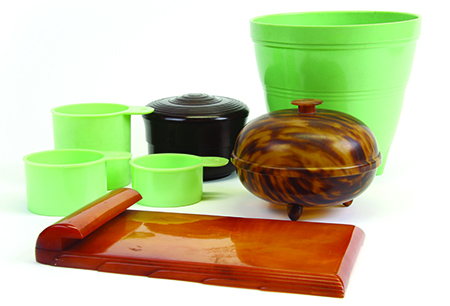
Some pieces from the collection made from urea formaldehyde, phenol formaldehyde, and cellulose nitrate |
At the beginning of the Second World War, plastics became heroes and were used in revolutionary technologies such as radar systems and in military aircraft, especially cockpit windows. All chemical industries focused on developing their polymers for use in the conflict. Moreover, shortages of natural materials encouraged them to do so. The production of these polymers during the war created a surplus of materials that had no place in society after 1945.

Cascelloid Sqezy bottles |
Especially since, for some of the general public, their image was associated with that of destructive devices. Fortunately, plastics brought a touch of colour and allowed for new designs. |
Easy-to-clean, disposable products were welcomed by many! As a result, the general public sometimes associates plastics with items that are described as kitsch, low-quality and cheap.
In the 1970s, the first environmental movements began to be very critical of plastics. At the same time, natural materials became fashionable. However, the technical advances of the 1980s brought polymers back into favour, particularly with the emergence of electronic devices for all. Thanks to plastics (and miniaturisation), all these high-tech devices fit in our pockets and are protected and insulated by robust plastics.
|
Today, everyone is increasingly aware of the impact that plastics have on the environment. |

A pair of Benson & Ashley tortoiseshell effect sunglasses dating from the 1990 |
In the 1950s and 1960s, plastics were seen as a very modern material. Are they still of interest to designers today?
It makes no sense that some designers and manufacturers avoid plastics simply because they are plastics. The 'no plastic' choice is not necessarily the most sustainable or practical. Just before the plastic straw ban in the UK, I was in a café in London and was given a paper straw for my drink. The waiter proudly pointed out to me that "here we are plastic free". He warned me not to leave the straw in my drink for too long or the paper would deteriorate quite quickly. Why such a substitution when it was so much simpler for me to do without a straw? In September 2022, during recycling week, vegetarian food company Linda McCartney Foods tweeted that it would be returning to using plastic trays to package its products. It had recently switched from plastics to aluminium, but found that by switching from aluminium to recycled PET, it reduced its carbon footprint by 60%. An astonishing figure for some, but it was proof that good design, especially in terms of sustainability, requires an overall assessment of where the material comes from, how it is managed at the end of its life, etc.
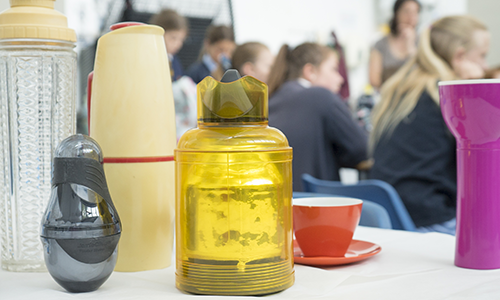
A group of household objects from the collection used to inspire school children |
Bioplastics, for example, especially those designed to biodegrade, are excellent because they avoid the use of fossil materials. This is true. However, they need to be managed with great care and in special processes to be completely eliminated. This shows that for each solution, a large number of questions need to be answered: Do biobased plastics have a negative impact on food land? Do they require excessive water and chemicals for their production? Are they by-products of another industry? Can they be composted at home? What about recycling issues if they end up in a waste stream? Will they emit gas when landfilled? There are so many things to consider!
What are your links with polymer manufacturers and processors?
The museum has no affiliation with the plastics industry. However, we do like to work with private organisations such as the British Plastics Federation. These types of partnerships help us to better understand the objects we have in the collection and allow us to have more technically informed materials for our visitors.
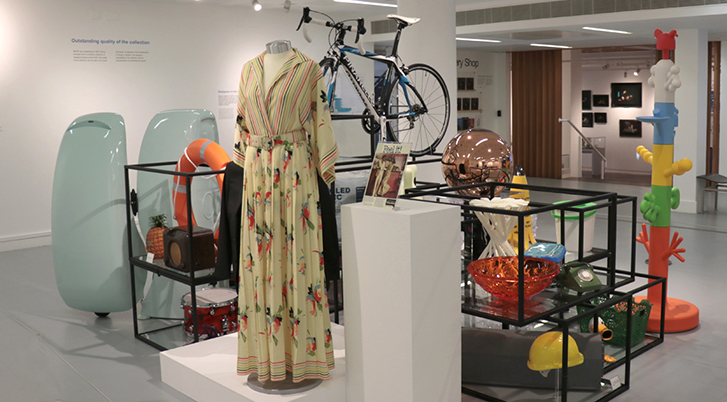
Objects in the museum’s ‘Designated Design: a plastics collection of national importance’ exhibition on display in the AUB’s Gallery |
How do you see the future of plastics?
Our societies have relied so much on the polymer family that I think it will be a long time before we turn our backs on them completely. They perform vital tasks by protecting us from hazards such as electrocution, by insulating electrical cables, by protecting us from various injuries, both at work and in sports. They also ensure the safety and preservation of food by creating a barrier to contamination. However, we are not always aware of their presence.

A display of AUB responses to the collection including work by students on courses such as fashion, commercial photography, fine art, illustration, and architecture |
I would like to think that in the future, the use of plastics will be more thoughtful, eco-designed, and that thought will be given to the relevance of their use and their end-of-life management. I believe that MoDiP and Plastics Le Mag in particular can play a role in showing designers, manufacturers and, primarily, consumers the value of this versatile family of materials. |
Dr. Louise Dennis is the curator of MoDiP. MoDiP is the only accredited plastics museum in the UK. It has been awarded Outstanding Collection status by Arts Council England.
Louise Dennis' research focuses on the museum's collection, and in particular on the historical and cultural relationships associated with these objects. Her work aims to show the value of plastics when used appropriately.
MoDiP’s current exhibition ‘Endurance’ which shows how good design, and the right choice of plastics materials, can play a part in reducing risk to life and help us to survive in a variety of situations, including out at sea, in the air, and when travelling at high speed
Image credit: Museum of Design in Plastics, Arts University Bournemouth




